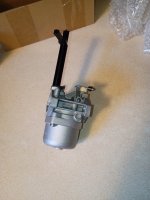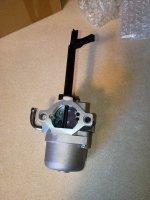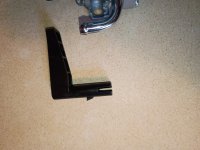I just received my new carburetor for my Briggs & Stratton Storm responder. I'm attaching a couple of photos. The lever that is on it to control the choke is not going to fit the application. The other lever that's included will. What's the safe way of removing the lever handle that's installed in the carburetor right now? I will wait for your words of wisdom before I attempt Small engine lung replacement, I think that's the correct metaphor...
You are using an out of date browser. It may not display this or other websites correctly.
You should upgrade or use an alternative browser.
You should upgrade or use an alternative browser.
Briggs & Stratton 8250 storm responder carb bowl held on with Phillips head screws???
- Thread starter Zzz
- Start date
More options
Export threadFellow Rust-belt dweller here. This is the voice of experience speaking (above, by @Craiger). Much wisdom here, for those open to it.I feel your pain. I live in the rust belt where they salt away snow unless it's more than 6" deep, only then will the plows come out. I have 8 cars and have done all my own work for 60 years and have learned how to remove frozen fasteners over that time. Many are correct that you should use a good penetrating oil and vibration to shock the corrosion bond between the steel threads and the alloy carb body. Rather than hammering on the screwdriver, I like to use a pneumatic hammer with a blunt punch dialed down to low pressure so you don't bugger anything. I use about 20-25psi. This works the pen. oil in MUCH better than tapping with a hammer. Do this several times a few hours apart with fresh applications of the oil. Wait overnight if you can and repeat the next day. If the screw refuses to budge, next thing I try is a needle nose genuine Irwin Vise-Grip pliers, not one from Harbor Freight. The steel is much better quality and bites better. Clamp it on the shoulders of the screw as tight as your strength allows and try to wiggle both clockwise and counter-clockwise just the tiniest bit and once you get noticeable movement, increase the swings to allow the penetrating oil to work it's way in. Add more if it remains stubborn. Now you can try the screwdriver to finish getting it out.
If that doesn't work, I use a dime-size diamond wheel in a Dremel tool to cut a complete slot across one of the Philips slots. Next get a good sharp flat blade screwdriver of the correct size. If your screwdriver is worn so the tip is rounded smooth (very common, most people never sharpen their screwdrivers) grab a new fine file and file the tip sharp carefully while holding the driver in a vise. Now with plenty of pressure pushing in on the screwdriver, unscrew the screw. You might need to put a wrench on the screwdriver, some screwdrivers can accomodate a box end wrench where handle meets shank, if not use a square shank screwdriver to get torque with an open end or Crescent wrench. One hand on the wrench, your strongest hand on the driver to avoid the bit walking out and buggering the screw head.
If the screw still refuses to come out, do whatever you can to remove any remaining traces of fuel from the carb with low pressure compressed air run for a half hour or more. Then use a propane torch to hit the stubborn screws and have a wet rag handy to smother a fire should it occur. Have new gaskets on hand if you have to resort to heat. If that fails you should drill out what's left of the screws and use a tap to rethread the carb. If that's been buggered, you will need to drill out to the next size larger screw and re-tap.
Once you've got the screws out, throw them away and buy Allen head machine screws of the right size and never face this problem again. Or use Torx screws if you can find them. Then there's standard hex head if neither of the above can be found. This may or may not be an option depending on if there's enough clearance to accomodate the hex head. I've been known to grind down the hex flats until I reach the right diameter for clearance. Use a fine grinding wheel. It's challenging to keep the flats in a hexagon! Tractor Supply stores generally have a really good selection of fasteners in pull-out drawers. I use a little bit of Nevr-Seez on the screw threads when putting steel screws into a dissimilar metal as is found in carb bodies. Let us know how you make out, good luck. Patience is a virtue...
Can I just pull the black choke controller lever off and replace it with the appropriate whatever? If yes what would be the appropriate way to remove the lever? I was thinking a screwdriver nudge on either side to free the lever from the carburetor. Let me know what you think. I am in the rust belt * 10. there is so much iron in the soil and the water here, it seems to exacerbate the oxidation process.
Best thing I did last year was take an inventory of every tool box, cabinet, parts for the garage. Same for the computer room/office/electronics and any other place where there are things I might need/want to find. I have three files about 10 pages each for the different locations saved as a PDF that can be quickly searched. Saved me several times but it is a challenge to keep it current. I'd say it's 99% right but entropy will have its way.....I picked one up from harbor freight and it was a little bit of Overkill but, like many of my other tools, I probably won't need it againbut if I ever do, I won't be able to find it

Forgot one modern tool that is easy to use and is a tremendous help....an induction heater. Red hot in seconds, no flame to deal with. I have a pencil model that I can change coil tips for smaller fasteners and another that will handle up to 7/8" fasteners. Above that it's usually oxy/acetylene with tips changed out to suit the job.Fellow Rust-belt dweller here. This is the voice of experience speaking (above, by @Craiger). Much wisdom here, for those open to it.
I use a small pair of Vise Grips the actual brand name ones and squeeze them very tightly in the proper direction around the outside of the screw and then I can crack them loose.Generator unit is about 14 years old Briggs & Stratton Storm responder 8250. Always run clean gas through the unit and use stabilizer. Change it every 6 months. This year it had all the signs of crap in the carburetor. I went to take the bowl off to give it a good cleaning and it's held on by Phillips head screws? They're not tough enough screws to handle the unscrewing process. Suggestions? Thanks for any ideas in getting this bowl off without doing major damage!
You won't need to put them back anywhere near as tight so you'll be fine.
If you're ever in a jam for a small JIS driver but happen to have a Reed & Prince driver, quite often that driver will operate the screw. I know it sounds odd because the R & P tapers to a fine point, but it works well on JIS when held at a tiny bit of an angle off perpendicular.
Taking an old "next size too large" phillips and grinding a bit of the tip flat also usually works on JIS.
I do the cut-off wheel in a Dremel tool trick mentioned earlier to make a slot for a flat blade screwdriver. And, if possible, stainless hex head goes back in.
Taking an old "next size too large" phillips and grinding a bit of the tip flat also usually works on JIS.
I do the cut-off wheel in a Dremel tool trick mentioned earlier to make a slot for a flat blade screwdriver. And, if possible, stainless hex head goes back in.




